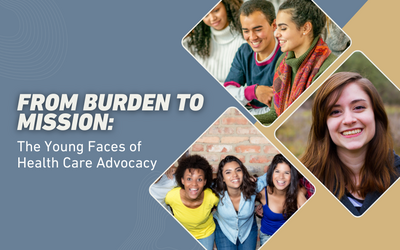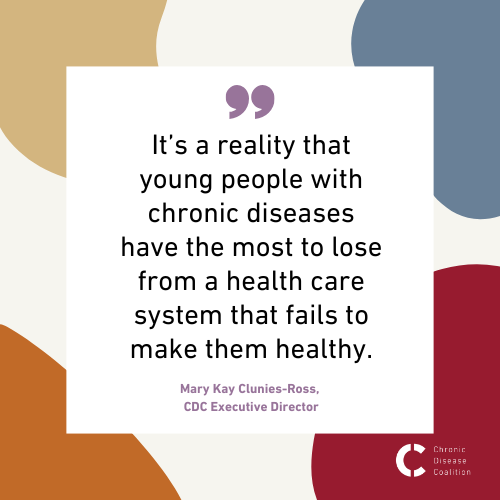
By Mary Kay Clunies-Ross, CDC Executive Director
The word “ambassador” has a connotation of stately old gentleman in tuxedos and sashes, whose main job is to attend state dinners. But let’s be clear: That’s not who the Chronic Disease Coalition ambassadors are. They're quite the opposite.
I meet with every ambassador to hear their story and answer questions about the Chronic Disease Coalition’s advocacy work. It's always humbling because by definition, these are people navigating flare-ups, appointments, and insurance mazes—and still showing up to shape the policies that affect all of us.
This year, though, I've particularly noticed how young the incoming ambassadors are.
“Being a high school student, I see the balancing act of school, social life, and advocacy as a privilege,” said Milli Garala. “I know that so many people are unable physically or mentally to manage all of these things at once. I try to get a lot of work done at school or during the week at home, so that I can focus on social life and advocacy on the weekends or in the evening. I also play varsity tennis, so I give myself time to recover and prioritize sleep, as you only heal while you are asleep.”
On one hand, it’s inspiring to see young people step into their roles as active participants in democracy.
Their advocacy is not a side hustle; it’s a public service rooted in lived expertise. When a 19-year-old with Crohn’s or a 22-year-old managing lupus testifies, meets with legislators, or mobilizes classmates, they put a human face on issues that can otherwise get lost in spreadsheets and statutes.
And they are participating. New research from Tufts University’s CIRCLE finds that in the 2024 election, an estimated 47% of Americans ages 18–29 cast a ballot, with turnout among the very youngest eligible voters (18–19) at 41%—remarkable persistence given economic headwinds and post-pandemic fatigue. These levels are below older age groups but well above where youth engagement stood a decade ago, proof that young people are a durable civic force.
On the other hand, and maybe it’s the parent in me, I hate that it’s necessary.
One conversation that has stuck with me was a young woman who was told that the fainting spells she was having in high school were “all in her head.” Her doctors had run out of answers, and so they blamed her. She didn’t accept their answer and began her own search for her own diagnosis (which she eventually found, by talking to the doctors who identified her extremely rare condition).
One of the challenges for young people is that they too often go undiagnosed or misdiagnosed because they fall outside of traditional age ranges for diseases. This means that their condition continues to worsen while they and their parents must continue to push doctors for care.
“I think my first turning point [in turning into an advocate] was being diagnosed correctly after being misdiagnosed with a variety of different skin diseases across my life,” Milli shared. “It was finally finding a doctor … I want people to advocate for second, third, fourth, or however many opinions they need to get. My second turning point was not knowing what my POTS diagnosis meant…. Now, I work to help make people aware of a syndrome that 1-3 million people in the USA have.”

With their whole lives ahead of them, young people need—and are willing to demand—better care, better diagnostics, better treatment, and more affordability. Many of our college-age ambassadors talk about the necessity of being covered by their parents’ health insurance, for example. When the only other option for health insurance is full-time employment, and you need health insurance to live, college is not an option.
Their voices are urgently needed.
Chronic conditions are rising among young adults, with Centers for Disease Control and Prevention(CDC)-affiliated researchers reporting significant growth from 2013 to 2023 in the share of young adults who have one or more chronic conditions. Affordability is a huge issue for young people who are looking at a lifetime of medical costs. It’s one thing to be diagnosed with a chronic disease when you’re 60—Medicare is just a few years away to pay the bills. But if you’re 20, with that same disease, looking at paying for decades of medication? It changes everything.
That burden translates into missed classes, medical debt, and barriers to work—realities that make policy personal and advocacy practical.
Young people are also (rightfully) in the position to be the loudest voices in the fight for cures.
“I hope that in 5-10 years from now, I will be able to do research on the genetic reasons behind my syndromes, in order to create cures and treatments. I hope to be a medical student, who understands the importance of her work because she is a Chronic Disease Coalition Advocate.”
If you work in health, education, or government, here’s the invitation: bring young patients to the table early, compensate them fairly, and close the loop by showing how their input changes outcomes. If you’re a peer living with a chronic condition, your experience is already expertise. Add your quote, your vote, your testimony—you’re not just advocating for yourself; you’re building a more humane system for everyone who will one day need it.